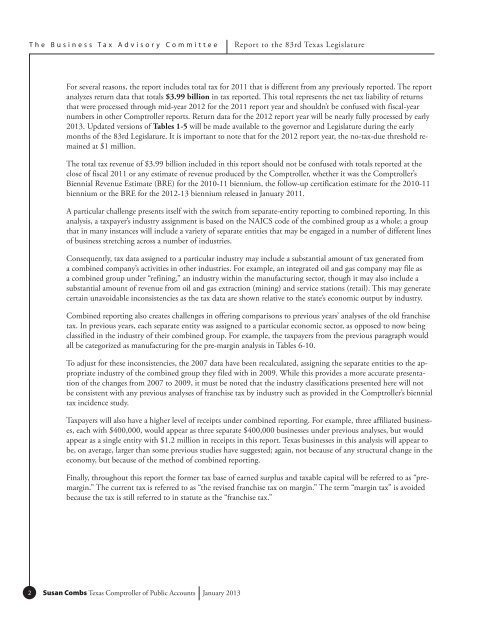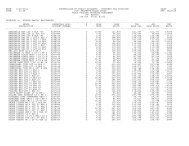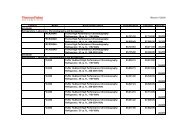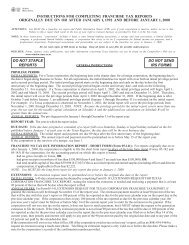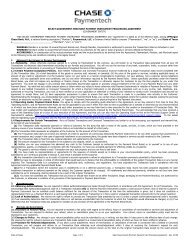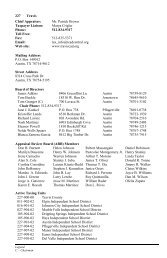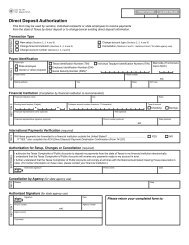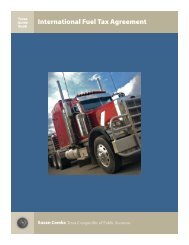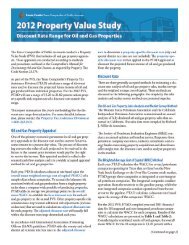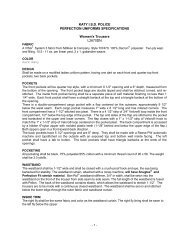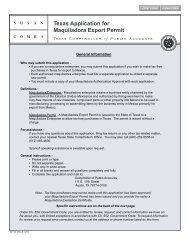96-1364 Business Tax Advisory Committee Report to the 83rd Texas ...
96-1364 Business Tax Advisory Committee Report to the 83rd Texas ...
96-1364 Business Tax Advisory Committee Report to the 83rd Texas ...
Create successful ePaper yourself
Turn your PDF publications into a flip-book with our unique Google optimized e-Paper software.
The <strong>Business</strong> <strong>Tax</strong> <strong>Advisory</strong> <strong>Committee</strong><strong>Report</strong> <strong>to</strong> <strong>the</strong> <strong>83rd</strong> <strong>Texas</strong> LegislatureFor several reasons, <strong>the</strong> report includes <strong>to</strong>tal tax for 2011 that is different from any previously reported. The reportanalyzes return data that <strong>to</strong>tals $3.99 billion in tax reported. This <strong>to</strong>tal represents <strong>the</strong> net tax liability of returnsthat were processed through mid-year 2012 for <strong>the</strong> 2011 report year and shouldn’t be confused with fiscal-yearnumbers in o<strong>the</strong>r Comptroller reports. Return data for <strong>the</strong> 2012 report year will be nearly fully processed by early2013. Updated versions of Tables 1-5 will be made available <strong>to</strong> <strong>the</strong> governor and Legislature during <strong>the</strong> earlymonths of <strong>the</strong> <strong>83rd</strong> Legislature. It is important <strong>to</strong> note that for <strong>the</strong> 2012 report year, <strong>the</strong> no-tax-due threshold remainedat $1 million.The <strong>to</strong>tal tax revenue of $3.99 billion included in this report should not be confused with <strong>to</strong>tals reported at <strong>the</strong>close of fiscal 2011 or any estimate of revenue produced by <strong>the</strong> Comptroller, whe<strong>the</strong>r it was <strong>the</strong> Comptroller’sBiennial Revenue Estimate (BRE) for <strong>the</strong> 2010-11 biennium, <strong>the</strong> follow-up certification estimate for <strong>the</strong> 2010-11biennium or <strong>the</strong> BRE for <strong>the</strong> 2012-13 biennium released in January 2011.A particular challenge presents itself with <strong>the</strong> switch from separate-entity reporting <strong>to</strong> combined reporting. In thisanalysis, a taxpayer’s industry assignment is based on <strong>the</strong> NAICS code of <strong>the</strong> combined group as a whole; a groupthat in many instances will include a variety of separate entities that may be engaged in a number of different linesof business stretching across a number of industries.Consequently, tax data assigned <strong>to</strong> a particular industry may include a substantial amount of tax generated froma combined company’s activities in o<strong>the</strong>r industries. For example, an integrated oil and gas company may file asa combined group under “refining,” an industry within <strong>the</strong> manufacturing sec<strong>to</strong>r, though it may also include asubstantial amount of revenue from oil and gas extraction (mining) and service stations (retail). This may generatecertain unavoidable inconsistencies as <strong>the</strong> tax data are shown relative <strong>to</strong> <strong>the</strong> state’s economic output by industry.Combined reporting also creates challenges in offering comparisons <strong>to</strong> previous years’ analyses of <strong>the</strong> old franchisetax. In previous years, each separate entity was assigned <strong>to</strong> a particular economic sec<strong>to</strong>r, as opposed <strong>to</strong> now beingclassified in <strong>the</strong> industry of <strong>the</strong>ir combined group. For example, <strong>the</strong> taxpayers from <strong>the</strong> previous paragraph wouldall be categorized as manufacturing for <strong>the</strong> pre-margin analysis in Tables 6-10.To adjust for <strong>the</strong>se inconsistencies, <strong>the</strong> 2007 data have been recalculated, assigning <strong>the</strong> separate entities <strong>to</strong> <strong>the</strong> appropriateindustry of <strong>the</strong> combined group <strong>the</strong>y filed with in 2009. While this provides a more accurate presentationof <strong>the</strong> changes from 2007 <strong>to</strong> 2009, it must be noted that <strong>the</strong> industry classifications presented here will notbe consistent with any previous analyses of franchise tax by industry such as provided in <strong>the</strong> Comptroller’s biennialtax incidence study.<strong>Tax</strong>payers will also have a higher level of receipts under combined reporting. For example, three affiliated businesses,each with $400,000, would appear as three separate $400,000 businesses under previous analyses, but wouldappear as a single entity with $1.2 million in receipts in this report. <strong>Texas</strong> businesses in this analysis will appear <strong>to</strong>be, on average, larger than some previous studies have suggested; again, not because of any structural change in <strong>the</strong>economy, but because of <strong>the</strong> method of combined reporting.Finally, throughout this report <strong>the</strong> former tax base of earned surplus and taxable capital will be referred <strong>to</strong> as “premargin.”The current tax is referred <strong>to</strong> as “<strong>the</strong> revised franchise tax on margin.” The term “margin tax” is avoidedbecause <strong>the</strong> tax is still referred <strong>to</strong> in statute as <strong>the</strong> “franchise tax.”2Susan Combs <strong>Texas</strong> Comptroller of Public Accounts January 2013


